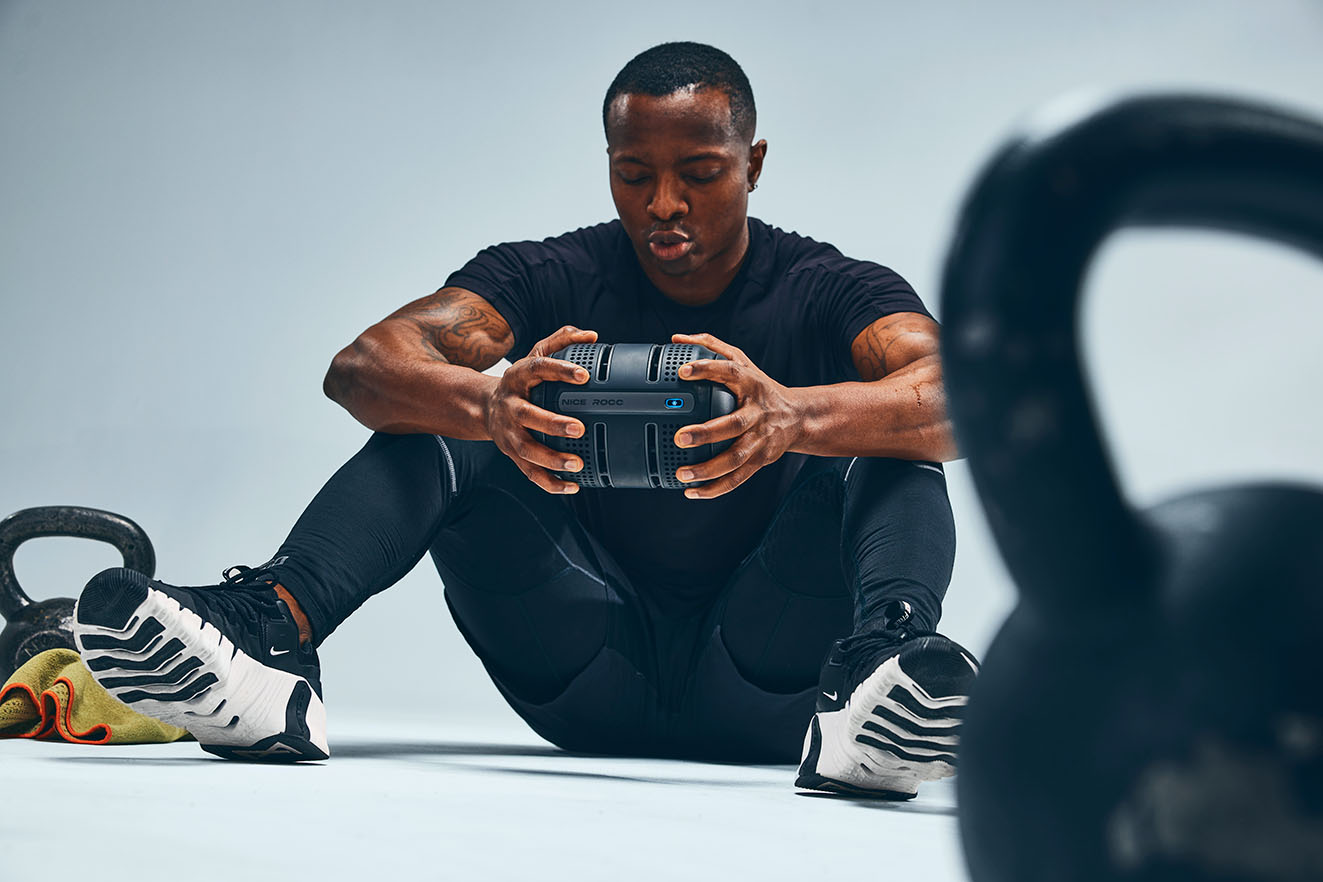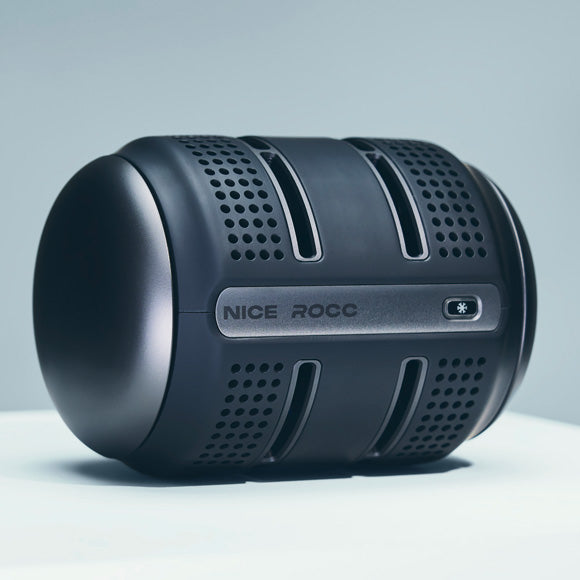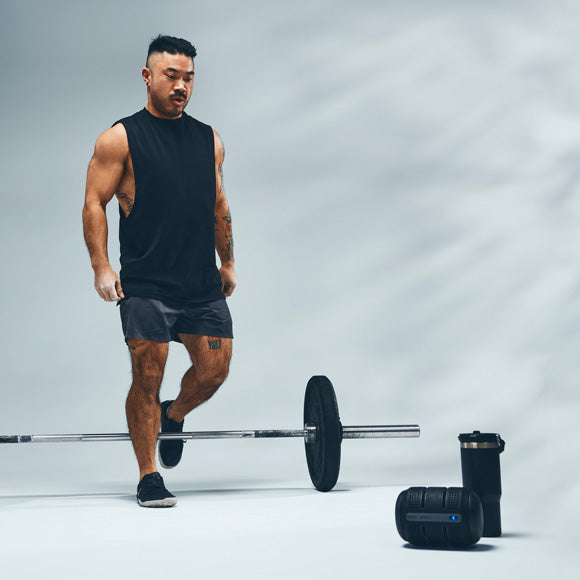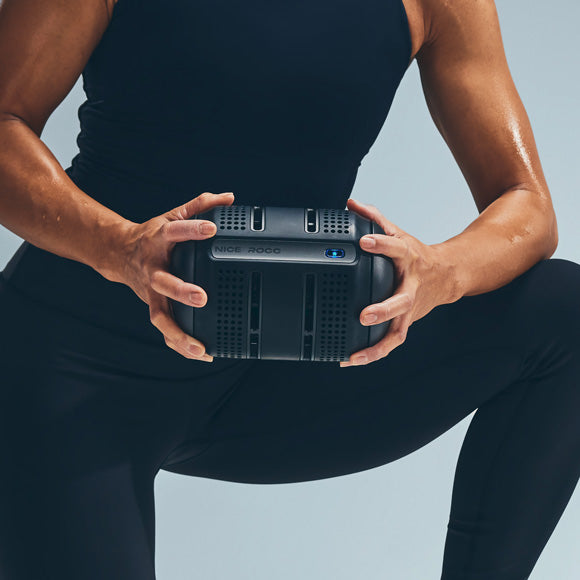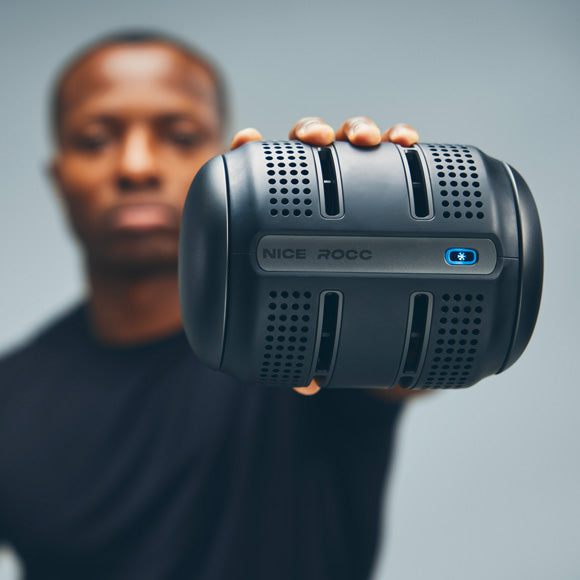Palm Cooling is a proven, science-backed method for accelerating recovery, enhancing stamina, and boosting overall athletic performance. By precisely managing body temperature through the hands, where specialized blood vessels can rapidly transfer heat, Palm Cooling helps athletes push past training plateaus and minimize downtime caused by heat-induced fatigue.
The concept may sound simple, but its implications are profound. From professional sports teams and college athletes to tactical professionals and everyday fitness enthusiasts, many people are discovering that this targeted form of thermoregulation can be a game-changer. Whether you’re aiming to extend time to exhaustion, add extra reps to your lifting routine, or keep cool during a long-distance race, Palm Cooling can give you a significant edge.
This comprehensive guide unpacks the science, offers step-by-step protocols, and highlights how NICE Recovery Systems’ ROCC device takes Palm Cooling to the next level with no ice or messy water, just reliable, on-demand cooling. Dive in to learn how mastering Palm Cooling can help you perform better, recover faster, and stay ahead of the heat.
Palm Cooling Defined
Palm Cooling is a targeted thermoregulation strategy that lowers core body temperature by cooling the blood in the palms. It leverages the body’s natural heat-exchange pathways, called arteriovenous anastomoses (AVAs), to quickly disperse accumulated heat. Rather than chilling the entire body with methods like ice baths or cold showers, Palm Cooling focuses on the hands, where the high concentration of these AVAs makes temperature control especially effective.
Core Benefits of Palm Cooling at a Glance
-
Delay Muscle Fatigue: Sustain ATP production by preventing overheating.
-
Boost Training Volume: Add more sets, more reps, or longer intervals.
-
Mitigate Heat Stress: Lower your core temperature effectively without full-body cooling.
-
Accelerate Recovery: Shorten downtime between high-intensity efforts.
By promptly reducing internal heat, you’re effectively resetting your muscles’ capacity to generate power. In competitive or training settings (whether that’s professional basketball, college football, or a tactical operation) every advantage matters, and Palm Cooling can often be the deciding factor.
Why Palm Cooling Improves Performance
Leveraging AVAs for Systemic Cooling
The human body dissipates heat in multiple ways, but the palms (along with around the eye and soles of the feet) have unique anatomical features that make them ideal for heat exchange. Arteriovenous anastomoses (AVAs) in glabrous skin bypass the tiny capillaries, offering a direct path for blood to circulate and release heat. When you apply a cool (not cold) stimulus in the optimal 50–60°F range, you draw heat from the blood without constricting vessels, ensuring a steady flow of cooler blood back to the heart and throughout the body.
Helping Muscles Maintain ATP Production
When muscles overheat, they struggle to produce and recycle adenosine triphosphate (ATP)—the energy currency for muscle contractions. In particular, the enzyme pyruvate kinase responsible for ATP generation becomes inhibited at high temperatures. By strategically cooling the palms, you keep ATP production efficient, enabling stronger, more prolonged muscle contractions and delaying the onset of fatigue.
Avoiding the Pitfalls of Overcooling
Unlike holding an ice pack, which can rapidly drop hand temperature below 50°F and induce vasoconstriction, Palm Cooling done correctly maintains an ideal temperature gradient. This precision fosters continuous blood flow without reflexive vessel constriction, making it more effective than general cooling methods that target large skin surfaces with inconsistent temperatures.
How Heat Leads to Fatigue
Heat triggers fatigue through multiple mechanisms. Here is a quick, bullet-based breakdown of why high temperatures can zap your strength and stamina:
-
Elevated Heart Rate: As core temperature rises, your cardiovascular system works harder to pump blood to the skin for cooling, leaving less capacity for fueling working muscles.
-
Redirected Blood Flow: Blood shifts toward the skin surface to dissipate heat, reducing the nutrient and oxygen supply to active muscles.
-
Inhibited Enzyme Function: The enzyme muscle pyruvate kinase gets suppressed at higher temperatures, slowing ATP production.
-
Accelerated Electrolyte Loss: Intense sweating depletes essential minerals like sodium, potassium, and magnesium, further contributing to fatigue and cramping.
By understanding these factors, it becomes clear why keeping muscle temperature in check is fundamental for enduring intense workouts and maximizing overall performance.
Peer-Reviewed Research on Palm Cooling
Academic and scientific studies underscore the efficacy of Palm Cooling, especially within the last 10 years. Below are some key publications that reveal how targeted hand-cooling can transform athletic performance and heat-stress management.
-
Heller, C. G., et al. (2012). Stanford University Research:
-
Finding: Athletes who cooled their palms between sets performed significantly more reps of bench press and pull-ups compared to those who used no cooling.
-
Link: https://news.stanford.edu/stories/2012/08/cooling-glove-research-082912
-
Grahn, D., et al. (2012). Journal of Strength and Conditioning Research:
-
Title: “Work Volume and Strength Training Responses to Resistive Exercise Improve with Periodic Heat Extraction from the Palm.”
-
Finding: Participants using periodic palm cooling increased total repetition volume by approximately 40%.
-
Grahn, D., & Heller, C. (2005). Journal of Applied Physiology:
-
Title: “Heat extraction through the palm of one hand improves aerobic exercise endurance in a hot environment.”
-
Finding: Cooling the palm at ~57°F slowed lactate buildup and reduced the rate of perceived exertion in middle-distance runners.
-
Link: https://journals.physiology.org/doi/full/10.1152/japplphysiol.00093.2005
-
O'Brien, I. T., et al. (2021). Journal of Strength and Conditioning Research:
-
Title: “Use of Gloves to Examine Intermittent Palm Cooling's Impact on Rowing Ergometry.”
-
Finding: Collegiate athletes using palm cooling during circuit training had lower heart rates and faster recovery times.
-
Grahn, D., et al. (2005). Journal of Applied Physiology:
-
Title: “Heat extraction through the palm of one hand improves aerobic exercise endurance in a hot environment.”
-
Finding: Targeted palm cooling improved time-to-exhaustion during cycling tests in high-heat conditions.
Each study points to a consistent theme: when muscles stay cooler, they can generate force and withstand fatigue more effectively. In short, controlling temperature through the palms can be a strategic edge for anyone serious about performance.
Real-World Applications and Use Cases
Palm Cooling’s versatility extends beyond the realm of elite athletes. Here’s a look at who can benefit from this cutting-edge method:
Professional and Collegiate Sports Teams
-
Basketball, Football, Soccer, Track & Field: Palm Cooling helps maintain peak power output during short, high-intensity bursts and aids in swift recovery during timeouts or halftime.
-
Olympians and Paralympians: Many of these world-class competitors employ advanced cooling strategies, including palm-based methods, to manage heat stress in events like marathons or multi-day tournaments.
Strength and Conditioning Athletes
-
Powerlifting and Weightlifting: Heavy lifting sessions often generate intense muscle heat; inter-set cooling sessions help preserve ATP levels for heavier lifts and more total volume.
-
CrossFit and HIIT: Short rest intervals benefit immensely from quick cooldowns, letting athletes sustain explosive performance across multiple rounds.
Serious Amateurs and Everyday Athletes
-
Dedicated Fitness Enthusiasts: Runners, cyclists, and triathletes looking to shave seconds off their mile times or sustain top speeds in training can use Palm Cooling to manage core temperature more efficiently.
-
Personal Trainers: Offering clients on-the-spot cooling solutions can enhance workout quality and reduce overall injury risk.
Tactical and Military Professionals
-
Firefighters: Quick palm cooling during incident rehab phases helps prevent dangerous spikes in core temperature, reducing heat-related risks.
-
Military Personnel: Soldiers often carrying heavy loads; portable devices can offer a tactical advantage and safety margin.
Practical Protocols and Timelines
How long you should cool your palms depends on the specific context and goals. Below are some research backed time-based guidelines:
In-Game and Practice Sessions
1–3 minutes of Palm Cooling during short breaks or timeouts reduces heart rate and prolongs high-intensity efforts.
Key Sources: Stanford University (Dr. Heller, Dr. Grahn) and Journal of Strength & Conditioning Research (2018).
Main Finding: Short intermittent palm-cooling intervals (1–3 minutes at 50–60°F) help lower heart rate and maintain higher-intensity output during timeouts or substitutions.
Resistance Training / Strength Gains
2–3 minutes of cooling between working sets helps delay muscular fatigue, enabling extra sets and reps. Athletes often describe a sense of “renewed freshness.”
Key Sources: Stanford University hand-cooling research, Journal of Strength & Conditioning Research (2018).
Main Finding: Cooling palms between heavy sets (2–3 minutes) delays muscle fatigue by preserving ATP production, enabling more reps and total volume.
Heat Stress Mitigation (Occupational or Athletic)
5–10 minutes of Palm Cooling can drop core temperature by approximately 0.5°C.
Key Sources: Stanford University (Grahn & Heller), occupational heat-stress studies (firefighting rehab protocols).
Main Finding: Intermittent palm-cooling sessions totaling 5–10 minutes can reduce core temperature by around 0.5°C, aiding workers and athletes in hot environments.
Pre-Race Cooling and Down Regulation
While less studied, 2–5 minutes of cooling before a race or after intense sessions can help maintain mental calmness and reduce perceived exertion before the next event.
Key Sources: Early “pre-cooling” research in endurance sports (European Journal of Applied Physiology), Stanford-based glabrous-skin studies, and anecdotal elite-athlete reports.
Main Finding: Brief (2–5 minutes) palm cooling before or immediately after intense efforts can improve mental calmness, lower perceived exertion, and facilitate faster recovery.
By structuring these protocols around your training schedule, you can better manage heat buildup and more consistently hit your workout targets.
NICE ROCC: The Best Palm Cooling Device for Enhancing Performance
Peltier Module for Continuous Cooling
At the heart of the NICE ROCC device is a Peltier module. This solid-state thermoelectric system pulls heat from one side of the device to the other, maintaining a steady, optimal cooling range (50–60°F) for as long as two hours on a single charge. Unlike single-use ice packs, chilled water, and frozen tubes, the ROCC stays consistent throughout your session.
Simple, Effective Usage
-
Power On: A single button or switch to activate the cooling system, with immediate effect.
-
Place Palms: Ergonomic surfaces designed to make firm contact with AVA-rich areas in your palm.
-
Check the Haptic Timer: Every set interval, a gentle vibration or alert reminds you to switch palms or return to your workout.
-
Continue Training: No wait time for temperature “recharge;” the ROCC remains cool without the need for water, freezers, or bulky external equipment. Ready for palm cooling? Just power up the ROCC and it’s in the palm of your hands.
Durability and Design
-
Solid-State Electronics: No moving parts to break down over time, ensuring reliability under rigorous conditions.
-
Machined Aluminum & ABS Plastic: Withstand drops, bumps, and the sweat of intense workouts.
-
Portable Weight (about 2 kg / 4.4 lbs): Easy to bring along to the gym, on the field, or anywhere else you need to train.
Learn more about the benefits of the ROCC.
Comparing Traditional Cooling Methods vs. ROCC Palm Cooling
Ice Packs and Cold Water Immersion
-
Pros:
-
Easily accessible (anyone can grab ice).
-
Provides a noticeable cooling sensation.
-
Cons:
-
Temperature often drops below 50°F, causing vasoconstriction and limiting blood flow and performance impact of palm cooling.
-
Messy to use; ice melts quickly, requiring constant replenishment.
-
Difficult to regulate precisely over extended periods.
Frozen Tubes or Improvised Methods
-
Pros:
-
Moderately portable, no advanced machinery required.
-
Cons:
-
Often lacks consistent cooling temperature.
-
Quickly lose their chill in warm environments.
-
Uncontrolled cooling can lead to too cold (below 50°F), reducing effectiveness.
The ROCC Palm Cooling Advantage
-
Precise Temperature Range (50–60°F): Prevents vasoconstriction, ensuring maximum heat transfer from blood to device.
-
No Need to Pre-Cool or Freeze: Self-contained, solid-state electronics handle cooling on the spot, not long wait and no messy ice or water.
-
Runs Over Two Hours Per Charge: Consistent operation without interruption or temperature drop-off.
-
Built-In Timer and Haptic Feedback: Optimizes usage intervals, so you stay focused on your performance rather than constantly monitoring temperature or time.
-
Designed by Studio F.A. Porsche: High-end industrial design paired with robust materials like machined aluminum and ABS plastic.
-
Proudly Made in the USA: Manufactured in Boulder, Colorado with stringent quality standards, ensuring durability under demanding sports conditions.
How to Incorporate Palm Cooling Into Your Training
-
Identify Your Primary Goal
-
Strength Gains, Endurance, HIIT, or Heat-Stress Management.
-
Different disciplines may require varied cooldown intervals (see Protocols & Timelines).
-
Slot Into Existing Routines
-
Between Sets: Hold the ROCC device for 2–3 minutes between heavy sets.
-
Interval Breaks: Athletes may opt for 20–30 seconds of cooling in short rest periods to sustain output.
-
Adjust and Experiment
-
Everyone’s thermoregulation differs. Monitor how you feel, track performance metrics, and tweak your cooling intervals accordingly.
-
Maintain a training log to identify patterns and make data-driven adjustments.
Additional Resource: A deeper dive into incorporating Palm Cooling into your training
Sport Specific Uses of Palm Cooling
The following articles go into more specific detail about using Palm Cooling for each of these sports and activities:
Safety Considerations and Best Practices
-
Consult Healthcare Professionals
-
If you have underlying health conditions (e.g., cardiovascular issues, Raynaud’s disease), seek medical guidance before introducing new cooling routines.
-
Aim for 50–60°F
-
Temperatures below 50°F risk vasoconstriction, negating the benefits of cooling. Above 60°F, heat transfer diminishes.
-
Start Gradually
-
Begin with short cooldown intervals; extend if you feel it’s beneficial and comfortable.
-
Stay Hydrated
-
Cooling doesn’t replace the need for water and electrolytes, especially in high-heat environments or lengthy workouts.
-
Prioritize Hand Contact
-
Ensure proper palm placement on the cooling surface. Full contact maximizes heat exchange.
Frequently Asked Questions (FAQ)
Q: How long should I cool my palms between sets?
A: For resistance training, 2–3 minutes typically works well to restore ATP production and delay fatigue. If you’re short on time, even a 60–90 second interval can help.
Q: Is Palm Cooling safe if I have a heart condition?
A: While Palm Cooling is generally safe, individuals with cardiovascular or circulatory conditions should consult a healthcare professional before adding any new thermal therapy to their regimen.
Q: Does Palm Cooling help with endurance sports?
A: Yes. By keeping your core temperature lower for longer, Palm Cooling can help runners, cyclists, and triathletes maintain pace and reduce the rate of perceived exertion over extended distances.
Q: How does the ROCC differ from ice packs or chilled water bottles?
A: Unlike ice packs, which can be too cold and cause vasoconstriction, the ROCC device uses solid-state electronics to maintain a consistent 50–60°F range, ensuring effective heat exchange without messy cleanup or temperature dips.
Q: Can I use Palm Cooling to reduce occupational heat stress (e.g., firefighters)?
A: Absolutely. Tactical and occupational personnel who work in hot or high-stress environments find significant relief and improved safety by quickly lowering core temperature during breaks.
Q: What if I don’t feel a dramatic effect right away?
A: Some individuals experience an immediate sense of relief, while others notice gradual benefits over multiple sessions. Consistency and proper technique (firm palm contact, correct duration) are key to reaping the rewards.
Moving Forward: Elevate Your Performance
Palm Cooling holds immense potential for athletes and fitness enthusiasts of all levels, military and tactical professionals, and anyone looking to perform better or recover faster. By harnessing the power of AVAs in the palms, you can optimize ATP production, sustain higher-quality training volume, and maintain mental clarity even in challenging conditions.
Ready to experience the benefits first-hand?
Explore the ROCC device from NICE Recovery Systems. Its precisely calibrated temperature range, solid-state Peltier module, and hassle-free operation offer the most advanced Palm Cooling on the market. Push harder, recover faster, and take control of your performance, one cool palm at a time.
